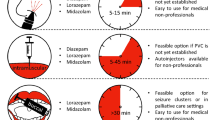Abstract
We studied the effect of morphine and naloxone on lower esophageal sphincter pressure, esophageal contraction amplitude, and gastric emptying of solids and liquids in ten normal healthy subjects. Morphine sulfate in a dose of 8 mg intravenous bolus significantly decreased sphincter pressure with a maximum fall of 22.8% of the basal tone. Naloxone, 5 mg intravenous bolus, resulted in a 20% increase in the baseline pressure. There was no change in the esophageal contraction amplitude, duration, or frequency of peristalsis with either morphine or naloxone. Gastric emptying was measured using a dual-isotope technique to simultaneously asses the emptying rates of both solid and liquid meal components. Morphine, 8 mg intravenous bolus, led to a significant inhibition (P<0.05) of the gastric emptying of both solids (99mTc sulfur colloid-labeled chicken liver) and liquids (111In DTPA-labeled water). Naloxone, 5 mg intravenous bolus, accelerated the gastric emptying of both solid and liquid components, but this did not achieve statistical significance. These observations suggest that: (1) morphine's inhibitory effect on gastric emptying and lower esophageal sphincter pressure may contribute to its potent emetic properties; (2) the human lower esophageal sphincter and stomach may have opiate receptors and further investigations should be addressed to determining if endogenous opiates play a role in the modulation of sphincter pressure and gastric emptying in humans.
Similar content being viewed by others
References
Hughes J, Smith TW, Kosterlitz HW, Fothergill LA, Morgan BA, Morris HR: Identification of two related peptides from the brain with potent opiate agonist activity. Nature 258:577–579, 1975
Polak JM, Bloom SR, Sullivan SN, Facer P: Enkephalin-like immunoreactivity in the human gastrointestinal tract. Lancet 1:972–974, 1977
Alumets J, Hokanson R, Sundler F, Chang KJ: Leu-enkephalin-like material in nerves and enterochromaffin cells in the gut. An immunohistochemical study. Histochemistry 56:187–196, 1978
Kelly KA: Motility of the stomach and gastroduodenal function.In Physiology of the Gastrointestinal Tract. LR Johnson. New York, Raven Press, 1981, pp 393–408
McCallum RW, Mensh R, Lange R: Definition of the gastric emptying abnormality present in gastroesophageal reflux patients.In Motility of the Digestive Tract. M Weinbeck. New York, Raven Press, 1982, pp 355–362
Meyer HJ, Macgregor MB, Gueller R, Martin P, Cavalieri R:99mTc tagged chicken liver as a marker of solid food in the human stomach. Am J Dig Dis 21:296–304, 1976
Edin R, Lundberg J, Terenius L, Dahlstrom A, Hokfelt T, Kewenter J, Ahlman H: Evidence for vagal enkephalinergic neural control of the feline pylorus and stomach. Gastroenterology 78:492–497, 1980
Feldman M, Walsh JH, Taylor IL: Effect of naloxone and morphine on gastric acid secretion and on serum gastrin and pancreatic polypeptide concentration in humans. Gastroenterology 79:294–298, 1980
McCallum RW, Dodds J, Osborne HP, Biancani P: Effect of enkephalin and other opiates on opossum lower esophageal sphincter.In Gastrointestinal Motility. J Christensen. New York, Raven Press, 1980, pp. 37–41
Rattan S, Goyal RK: Identification and localization of opioid receptors in the opposum lower esophageal sphincter. J Pharmacol Exp Ther 224:391–398, 1983
Sawynok J, Pinsky C, Labella FS: On the specificity of naloxone as an opiate antagonist. Life Sci 25:1621–1632, 1979
Konturek SJ: Opiates and the gastrointestinal tract. Am J Gastroenterol 74:285–291, 1980
Dajani SZ, Roge EAW, Bertezmann RE: Effects of E prostaglandins diphenoxylate and morphine on intestinal motilityin vivo. Eur J Pharmacol 34:105–113, 1975
Konturek SJ, Thor P, Knol R, Dembinski A, Schally AV: Influence of methionine enkephalin and morphine on myoelectrical activity of small bowel. Am J Physiol 238:G384–390, 1980
Sarna S, Northcott P, Belbeck L: Mechanism of cycling of migrating myoelectric complexes effect of morphine. Am J Physiol 242:G588–595, 1982
Telford GL, Szurszewski JH: Morphine induces migrating myoelectric complexes in fed dogs. Dig Dis Sci 27:52, 1982 (abstract)
Krueger H: The action of morphine on the digestive tract. Physiol Rev 17:619–645, 1937
Champion MC, Sullivan SN, Chamberlain M, Vezina W: Naloxone and morphine inhibit gastric emptying of solids. Can J Physiol Pharmacol 60:732–734, 1982
Shea-Donohue PT, Adams M, Arnold J, Dubois A: Effects of met-enkephalin and naloxone on gastric emptying and secretion in rhesus monkeys. Am J Physiol 245:G196-G200 1983
Shang JC, Devroede G: Beneficial effects of naloxone in a patient with intestinal pseudoobstruction. Am J Gastroenterol 80:407–411, 1985
Author information
Authors and Affiliations
Rights and permissions
About this article
Cite this article
Mittal, R.K., Frank, E.B., Lange, R.C. et al. Effects of morphine and naloxone on esophageal motility and gastric emptying in man. Digest Dis Sci 31, 936–942 (1986). https://doi.org/10.1007/BF01303214
Received:
Revised:
Accepted:
Issue Date:
DOI: https://doi.org/10.1007/BF01303214




